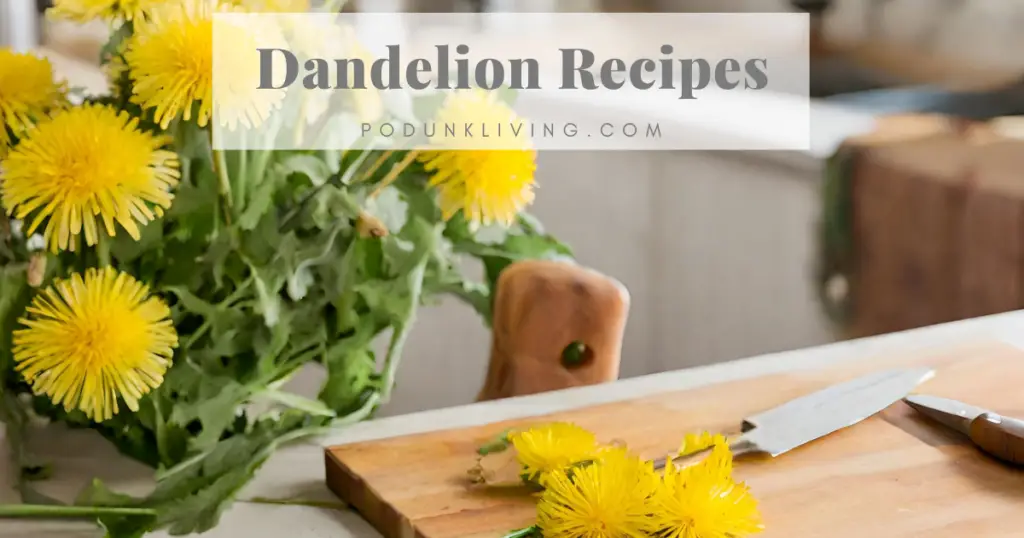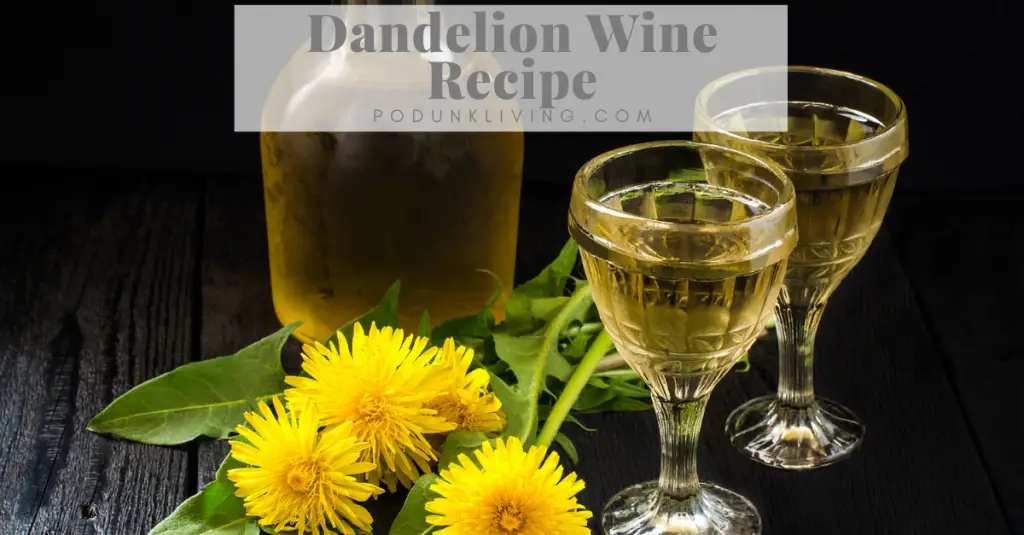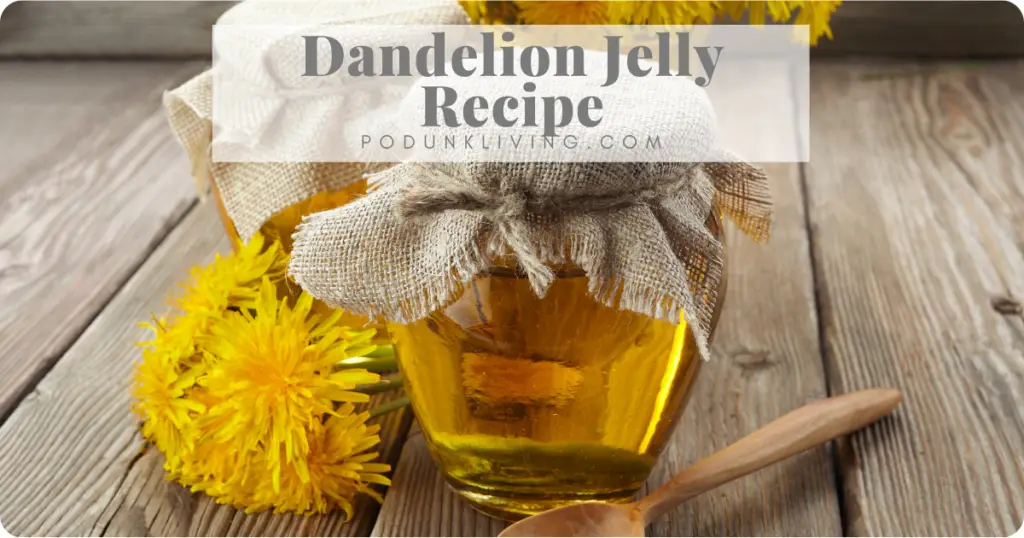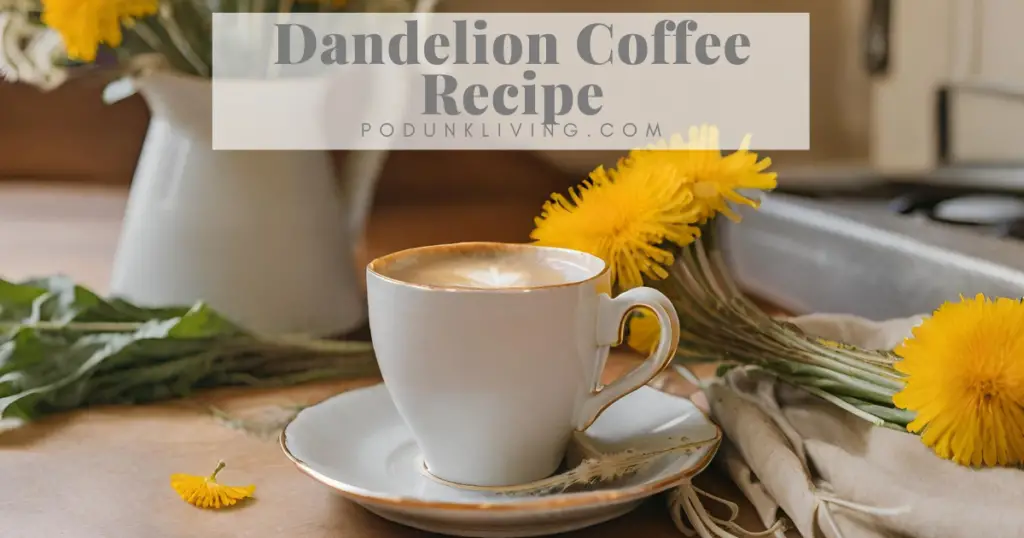Dandelion Recipes and Their Benefits
Make the most out of those relentless weeds, with these dandelion recipes. Dandelions are a productive herb that also offers health benefits that are almost too good to be true. They can detox your liver, help with weight loss (by making other foods taste better), aid digestion, and pack a punch of antioxidants (ensuring you glow like a firefly in June). And for the ladies, dandelion tea might save the day during PMS – so swap the chocolate for this bitter herbal remedy. I’ll bet you never thought of dandelions as an herb before (let alone a dandelion recipe)!
Health Benefits of Dandelions
- Cardiovascular Concoction: This study showed that 250 grams of dandelion root extract per day for a month had antioxidant properties and improved cardiovascular thickness. Dandelion root has also been shown to have anticoagulant properties with minimal side effects, which also help people with cardiovascular disease. The diuretic effects of dandelion root also help those suffering from heart failure.
- Weight-loss Wonder: This study found that 150 mg per kg of dandelion extract for 10 weeks had anti-obesity effects, decreasing body weight while consuming a high-fat diet.
- Greatful GI: This study found that dandelions have positive effects against dyspepsia, GERD, ulcerative colitis, and GI malignancy. In fact, this study showed that dandelion root kills aggressive colon cancer cells, without the adverse effects on non-cancerous colon mucosa (unlike chemo).
- Lively Liver: This study found that dandelion roots and leaves have positive effects against liver disease, gallstones, and acute pancreatitis.
- Diabetes Deterant: This study on dandelion extracts revealed that it may stimulate the release of insulin in pancreatic β-cells, which consequently counteracts the effects of hyperglycemia. Studies in diabetic rats have demonstrated that dandelion induces a decrease in glucose plasma concentration, which improves the insulin secretion activity of β-cells.
- Anti-oxidant Agent: Recently, this study found dandelion root is a potent anti-oxidant, which reduces the illnesses associated with aging like Alzheimer’s disease, Parkinson’s disease, arthritis, cardiovascular disease, asthma, and infertility.
Common Pesticides Applied to the Dandelion Plant
Herbicidal superstars, like 2,4-D and glyphosate, are used to give dandelions a taste of their own bitter medicine. Dandelions are far too generous, spreading their weedy love all over our pristine lawns. We can’t have those cheerful yellow invaders disrupting the perfection of our grassy canvas, can we? Instead of dousing them with chemicals just to keep our lawns looking as unnatural as possible, try harvesting them instead.
Other Agricultural Uses for 2,4-D and Glyphosate
2,4-D and glyphosate are like the uninvited party crashers at the crop celebration – they may not be the life of the party, but they sure know how to make an entrance!
- Corn: Ah, corn, the unsuspecting victim. When 2,4-D and glyphosate show up, it’s like a surprise party where the guests are all plants, and the party favors are… well, chemicals.
- Soybeans: These poor soybeans thought they were just going to grow up to be tofu, but instead, they get a dose of 2,4-D and glyphosate – it’s like a soybean spa day, with extra chemicals!
- Cotton: Cotton, the fabric of our lives, gets a little extra “oomph” from these chemicals. Who doesn’t want their clothes to come with a side of pesticides?
- Wheat: The staff of life, wheat, doesn’t escape either. It’s like the 2,4-D and glyphosate duo decided that bread needed a little extra zing.
- Canola: Canola oil? More like “Chemola” oil when these pesticides are in town. Because who doesn’t love a dash of chemicals with their stir-fry?
Health Effects of Glyphosate and 2,4-D
Ah, 2,4-D and glyphosate, the dynamic duo of dandelion destruction! These chemicals are like a bad comedy act when it comes to health effects. Remember when you’re spraying these chemicals on your lawn, you’re not just getting rid of weeds; you’re introducing your body to a whole new world of, um, “interesting” experiences.
- 2,4-D, also known as synthetic auxin, can have you feeling like a plant that’s lost its way, causing nausea, vomiting, and even neurological issues. Imagine you’re trying to tango but end up doing the Macarena instead!
- Round-Up the glyphosate, our friendly neighborhood weed killer. It might not give you superpowers, but it has been associated with disruptions in the endocrine system. It’s like your hormones are suddenly auditioning for a reality TV show – chaos ensues. Plus, glyphosate has been linked to potential carcinogenic effects. It’s like playing Russian roulette with your health, but instead of bullets, you’re dodging dandelions.
Dandelion Season
Oh, dandelions, the eternal party crashers of your lawn! In the fabulous land of America, these herbs have quite the social calendar:
- Dandelion Leaves: Well, get ready for the dandelion salad extravaganza! Those bitter greens emerge like rebellious teenagers, usually in the spring when you’re still mourning the loss of winter comfort food. Just when you’re craving venison pot pie, dandelion greens say, “Salad, anyone?”
- Dandelion Flower Blossoms: The dandelion’s short-lived moment of glory! Those golden blooms show up fashionably late in late spring to early summer, turning your lawn into a yellow carpet event. It’s like nature’s version of the red carpet, and you’re the celebrity.
- Dandelion Roots: And now, for the underground stars – dandelion roots! They’re at their prime in the fall, after the first frost. While you’re busy carving pumpkins and sipping pumpkin pie moonshine, dandelions are like, “Start digging, true health runs deep!”
How to Grow Dandelion Plants
- Annual or Perennial: Dandelions in the United States – they’re like the indecisive party guests who just won’t leave! These buggers are perennial, which means they keep coming back, year after year. They’re like the relatives who crash at your place for a weekend and end up moving in for a lifetime. So, while other plants follow the rules and have a set schedule, dandelions? Well, they’re the rebels of the garden!
- Sunlight Requirements: The simple dandelion, is the picky diva of the plant world! Dandelions prefer sunshine conditions that make them feel like they’re lounging on a tropical beach. Think relentless, scorching sun with no shade in sight – the kind of sunshine that makes sunbathing lizards jealous. These plants thrive in the sun so much, they might as well have sunscreen and tiny sunglasses. It’s like they’re on a never-ending summer vacation, while the rest of the garden wilts in jealousy! While dandelions, the sun-worshippers, might occasionally tolerate a bit of shade, it’s like inviting them to a gloomy, overcast picnic – they won’t be as enthusiastic. In the shade, they might show up with smaller leaves and fewer flowers, like they’re saying, “Fine, we’ll hang out here, but we’re not going to like it!” So, while dandelions prefer the spotlight, they can handle a bit of shade, but they won’t be the life of the garden party.
- Planting Season: You can sow dandelions whenever you want (anytime between spring and fall is best)! No need for precise timing; these rebels will pop up when they feel like it. Just toss some seeds casually, and watch the dandelions take over your yard. No green thumb is required!
- Harvest Time: The best part about growing dandelions, is that they will provide a harvest all year long! Dandelion greens will emerge in early spring, and hibernate in late fall. By late spring and early summer, you’ll see those yellow flowers that you can pluck. After the first frost, the dandelion roots will be prime for harvest. It’s a bit like a surprise party in your backyard – you never know when it’s happening, but it’s always a blast!
Planting Dandelions
Growing dandelions in your garden? Well, you’re in for quite an adventure! Here’s what you need to know:
- Sun Lovers: Dandelions are sun-worshippers, so give them plenty of light. They’re like the sunbathers of the plant world, and they’ll soak it up.
- Low-Maintenance Friends: If you’re looking for an easy relationship with your garden, dandelions are your BFFs. They need minimal care and attention. Just plant them, and they’ll do their thing, and enjoy their flowers.
- Persistent Pests: Be prepared for some unwanted guests in the form of dandelions – they’re persistent! They’ll pop up wherever they please, but that’s part of their charm, right?
- Edible Bounty: Dandelion greens are edible and quite nutritious, but make sure to harvest them before they get too bitter. They’re like your free homemade garden salad leaves. Parmesan anyone?
- Resilient Weeds: Dandelions are survivors. They have deep taproots that make them hard to get rid of, so get ready for the long haul if you decide to grow them intentionally.
- Pollinator Party: Dandelion blooms are like a helpful open invitation to pollinators. Bees and butterflies will thank you for the flower snack bar in your garden (and reward you with a bountiful garden and honey).
- Careful Location: If you’re growing dandelions intentionally, choose a spot where you don’t mind a view of their wild appearance. They can be a bit unruly, but that’s all part of the fun.
- Spacing: When planting dandelions intentionally, spacing is not typically a concern because these persistent little weeds have a way of filling in any available space. They can pop up and thrive even in close proximity to each other. So, you don’t need to worry about specific spacing for dandelions in your garden. In fact, dandelions are known for their resilience and ability to grow tightly together, creating that characteristic yellow carpet effect. Just plant them where you want them, and they’ll do their thing, filling in the gaps with their bright blooms. Think of them as the social butterflies of the plant world – they like to be close!
Harvesting Dandelions
Dandelions can add unique flavors and nutritional value to your meals and beverages, making them a delightful addition to your culinary recipe adventures! Harvesting dandelion leaves, blooms, and roots can be a fun and rewarding endeavor, but there are a few things to keep in mind with these ingredients:
Harvesting Dandelion Greens:
- Timing: Harvest dandelion greens when they’re young, usually in the spring or early summer. They’re less bitter at this stage (and can be used in most recipes).
- Harvesting: Use scissors or a knife to cut the greens near the base. Make sure to avoid plants that have been treated with herbicides.
- Cleaning: Rinse the greens thoroughly to remove dirt and insects. You can soak them in cold water to refresh them.
- Uses: Dandelion greens can be used in salads, sautéed dandelion greens (that taste like green beans), or as a substitute for spinach or kale. If you find the dandelion greens too bitter, try blanching or sautéing them to mellow the flavor.
Harvesting Dandelion Flower:
- Timing: Pick dandelion blooms when they’re fully open and bright yellow. Avoid ones that are turning fluffy with seeds.
- Harvesting: Gently pluck the blooms from the stem. Be mindful of any insects hiding in the flowers.
- Use: Dandelion flowers can be made into fried dandelions, used to make dandelion tea, dandelion wine, dandelion jelly, dandelion syrup (also known as vegan honey), or as a garnish for salads.
Harvesting Dandelion Root:
- Timing: Fall is the best time to harvest dandelion roots when the plant’s energy is in the root.
- Harvesting: Use a shovel or garden fork to dig up the roots. Try to get the entire taproot.
- Cleaning: Wash the roots thoroughly and scrub off the dirt. You can chop them into smaller pieces.
- Drying: To store dandelion roots, dry them in a well-ventilated area or use a dehydrator. Once dry, store them in an airtight container.
- Uses: Dandelion root makes a great addition to coffee or tea, herbal tinctures, or can be used as a substitute for carrots (like sauteed carrots or in your favorite carrot cake recipe).
Storing Dandelions for Recipes
Dandelion greens, blooms, and roots have their quirks when it comes to storage. If you don’t want your harvest to go to waste, make sure you have a plan in place! Here’s a practical rundown of how long you can store them with each method:
Storing Dandelion Greens:
- Room Temperature: It’s not recommended to store dandelion greens at room temperature for an extended period, as they can wilt quickly. Use them within a day or two.
- Fridge: In the refrigerator, dandelion greens can stay fresh for about 3-5 days if stored in a plastic bag with a damp paper towel to maintain moisture.
- Freezer: You can blanch dandelion greens and store them in the freezer for up to 6-12 months. They might not be as crispy when thawed, but they’ll work well in cooked dishes.
- Dehydrate: Dandelion greens can be dehydrated and stored for a year. Dehydrated dandelion greens are good for herbal remedies and tea (and are packed full of nutrition).
Storing Dandelion Blooms:
- Room Temperature: Dandelion blooms are best enjoyed fresh, but they can be placed in a vase with water and will last a few days as a unique floral arrangement.
- Fridge: In the refrigerator, dandelion blooms can stay fresh for 2-3 days if placed in a container with water.
- Freezer: Freezing dandelion petals is a great way to prepare smaller batches of dandelion blossoms for wine or jelly. The best way to freeze dandelion blossoms is to pick off all of the green material right away, while the flower is still open. Then, freeze in ziploc bags for up to 12 months, until you’re ready to use them in your recipe.
- Dehydrate: Dandelion flowers can be dehydrated and stored for a year. Dehydrated dandelion blossoms are good for tea and herbal remedies.
Storing Dandelion Roots:
- Room Temperature: Dandelion roots should not be stored at room temperature; they’ll dry out quickly.
- Fridge: Store dandelion roots in the refrigerator for up to 2 weeks in a plastic bag to retain moisture.
- Freezer: You can freeze dandelion roots after washing and slicing. They’ll keep for 12 months when stored this way, ready for your next recipe.
- Dehydrate: Dandelion root can be dehydrated and stored for a year. Make sure to clean the root before dehydrating, or you’ll end up with some extra flavoring (a great addition to your favorite recipes).









